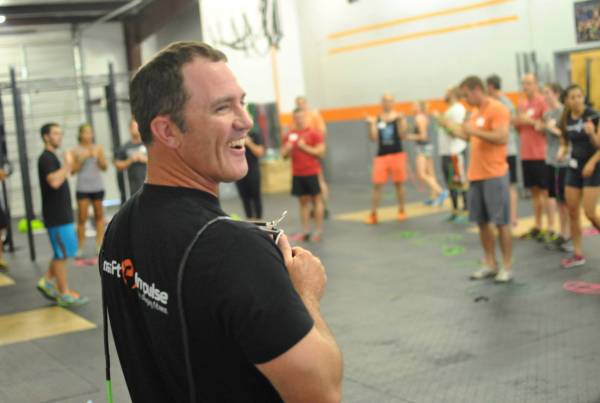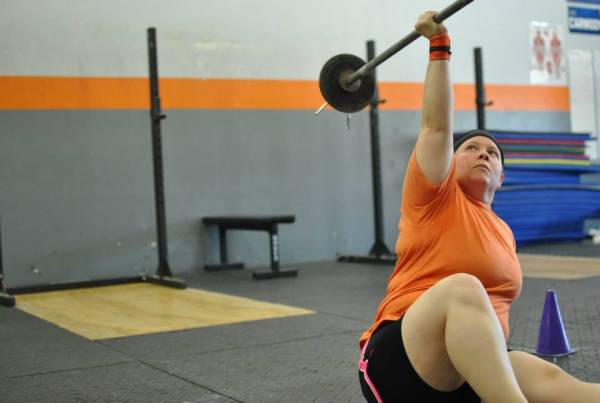I know many owners of CrossFit gyms have already programmed and enacted an on-ramp program that all new clients must participate in before actually working out in classes. If you have not started an on ramp program, I hope this article will shed some light as to why you need to start one.
What Is an On-Ramp Program?
An on-ramp is the course that teaches the foundational movements of CrossFit, plus other movements that are frequently used during WODs. On-ramps also teach the language of CrossFit, meaning all the acronyms, the benchmark workouts, and the significance of Hero WODs.
Most on-ramps last four to six weeks and usually are three to four days per week. Most gyms start courses once or twice a month, and those new to CrossFit can join during those on-ramp start-up periods.
Lower Your Injury Rate
The more people are educated about their bodies and how to do movements correctly, the lower your gym’s injury rate will be. Throwing a new person into a class without knowing the exercises can cause problems for everyone.
A study by the Journal of Orthopaedic and Sports Medicine examined the injury rate and patterns among CrossFit athletes. A survey was conducted based on validated epidemiologic injury surveillance methods to identify patters of injury in those who participated in CrossFit. Data was collected from October 2012 to February 2013.
The results showed a total of 486 CrossFit participants completed the survey and 386 met the inclusion criteria. The overall injury rate was shown to be 19.4%, with males injured more frequently than females. The shoulder was most commonly injured in gymnastic movements, and the low back was most commonly injured in powerlifting movements. Lastly, the injury rate was significantly decreased with trainer involvement.
The biggest take-away from this study is that more coaches involvement in regards to instructing and guiding people in movements correlates to a decreased injury rate.

Introduction to Your Social Environment
Humans are pack animals by nature and evolutionary standards. If your gym is similar to your home, you will create a bit of a pack mentality there. This isn’t a bad thing. It creates strong bonds between you and those you workout with. But this scenario can be intimidating to those who are new to the atmosphere, no matter how welcoming you are. It isn’t because of the people, but more because they sense, “This is not my house and I do not know the rules.”
An on-ramp puts everyone new together and gives them a coach as a guide. This is when you introduce the rules of your box and how things operate. This is when the newcomers get an idea of the social atmosphere that is developed at your box and how they fit into it. Since CrossFit runs classes in a community setting, these are things people have to figure out one way or another when they go into your box – an on-ramp program help with this.
Teaching Modifications
I can’t stress enough about modifications. Each body is different and an on-ramp will help coaches get to know every new person coming in and their associated physical issues. The on-ramps help coaches learn about each person individually and how they can help their needs.
You may have someone coming in who has had a shoulder surgery and was just released to come back and work out. Without the on-ramp it is hard to give someone in that situation the attention they need. Or what about someone with osteoporosis? Or any number of other chronic or temporary conditions? Exercise can be a form of medicine for many people, but it’s important for coaches to know how to modify for different people and goals.

An Emphasis on Nutrition
Have you ever heard the saying you can’t outrun a bad diet? I believe this is true, but many new to exercise don’t know much about nutrition. The on-ramp should include at least an introduction to healthy eating. Going to your box is the first step, and the good gyms usually advocate some sort of dietary change in order to fully transform a person’s lifestyle.
A study conducted by Appetite aimed to see correlations between nutrition knowledge and dietary behaviors. The study was a postal survey, using 1,040 adult participants selected at random from general practitioners’ lists in England.
Logistic regression showed that respondents in the highest quintile for knowledge were almost 25 times more likely to meet current recommendations for fruit, vegetables, and fat intake than those in the lowest quintile. Even though this study shows much in the world of statistics, it also shows us that knowledge is an important factor in explaining variations in food choices. As they say, knowledge is power.
The Conclusion on On-Ramps
Your on-ramp program should be one of the most important things you program because it builds the foundation for each member of your gym. Your on-ramp should be updated every few months based on how your new athletes are progressing and what is missing from their experience. Based on this, each box will bring in ideas and factors unique to their community.
The benefits discussed above are just a few that you will gain from enacting an on-ramp program. And I can’t stress enough the importance of having these programs to ensure the safety of your clients.
Those of you who have an on ramp, do you have any other benefits to add to this list? Do you have any advice to those who have not put one into action?
References:
1. Beck, Christopher PhD, et. al. “Injury Rates and Patterns Among CrossFit Athletes.” Journal for Orthopaedic Sports Medicine (2014): PDF, accessed August 11, 2014, doi. 10.1177/2325967114531177
2. Wardle, J. et. al. “Nutritional Knowledge and Food Intake.” Appetite (2000): 296-275, accessed August 11, 2014, doi. 10.1006/appe.1999.0311
3. Durstine, Larry J. et. Al. ACSM’s Exercise Management for Persons with Chronic Diseases and Disabilities. (Illinois: Human Kinetics, 2009), Kindle Edition.
4. Barker, Lewis. Psychology. (New Jersey: Prentice Hall, 2002), 98-100.
Photos courtesy of CrossFit Impulse.






